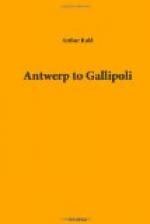“When you return from Constantinople,” she flashed back as they left the table, “don’t forget!”
These were the first Rumanians I had met. They were amiable, they spoke French—it almost seemed as if they had heard the tales that are usually told of their little capital, and were trying to play the appropriate introduction to Bucarest.
Here it is, this little nation, only a trifle larger than the State of Pennsylvania, a half-Latin island in an ocean of Magyars and Slavs. On the north is Russia, on the south the grave and stubborn Bulgars (Slav at any rate in speech), on the west Hungary, and here, between the Carpathians and the Black Sea, this Frenchified remnant of the empire of ancient Rome. Their speech when it is not French is full of Latin echoes, and a Rumanian, however mixed his blood, is as fond of thinking himself a lineal and literal descendant of the Roman colonists as a New Englander is of ancestors in the Mayflower. At the Alhambra in Bucarest next evening, after the cosmopolite artistes had done then-perfunctory turns and returned to their street clothes and the audience, to begin the more serious business of the evening, the movie man in the gallery threw on the screen—no, not some military hero nor the beautiful Queen whose photograph you will remember, but the head of the Roman Emperor Trajan! And the listless crowd, drowsing cynically in its tobacco smoke, broke into obedient applause, just as they would at home at the sight of the flag or a picture of the President.
Bucarest, like all the capitals of Spanish America, is another “little Paris,” but the Rumanians, possibly because unhampered by sombre Spanish tradition or perhaps any traditions at all, succeed more completely in borrowing the vices and escaping the virtues of the great capital they are supposed to imitate. It would be more to the point to call Bucarest a little Buenos Aires. There is much the same showiness; a similar curious mixture of crudeness and luxury. But Buenos Aires is one of the world’s great cities, and always just beyond the asphalt you can somehow feel the pampa and its endless cattle and wheat. The Rumanian capital is a town of some three hundred thousand people in a country you could lose in the Argentine, and there is nothing, comparatively speaking, to offset its light-mindedness, to suggest realities behind all this life of patisserie.
You should see the Calea Vittorei on one of these warm summer evenings between five and eight. It is a narrow strip of asphalt winding through the centre of the town, with a tree-shaded drive at one end, and the hotels, sidewalk cafes, and fashionable shops at the other, and up and down this narrow street, in motors, in open victorias driven by Russian coachmen in dark-blue velvet gowns reaching to their heels, all Bucarest crowds to gossip, flirt, and see.




